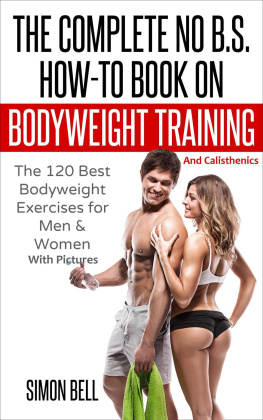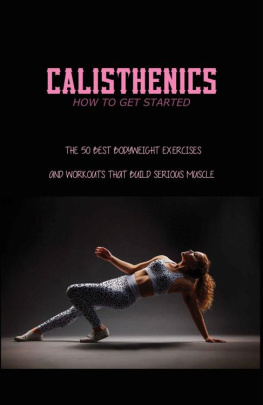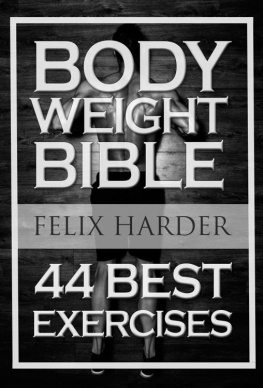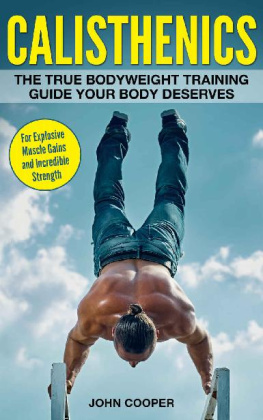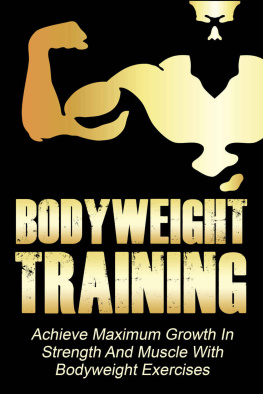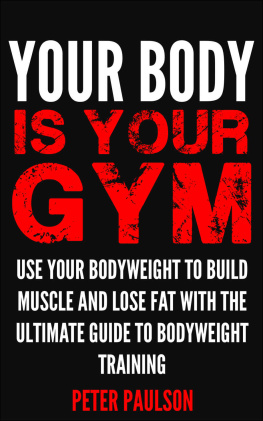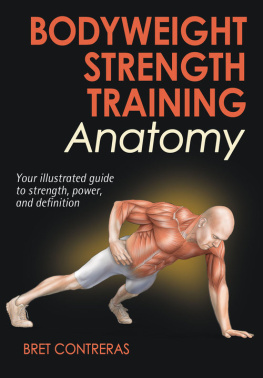Copyright 2018 by Anthony Arvanitakis
http://www.bodyweightmuscle.com
WARNING / DISCLAIMER
This information in this book is presented with good intentions. You must always consult your physician prior to starting any exercise program, especially if you have any medical condition or injury that contraindicates physical activity. All forms of exercise pose some inherent risks. You must take full responsibility for your safety and know your limits. Before practicing the exercises in this book, make sure that any kind of equipment or surface you train on is well maintained. Do not take risks beyond your level of experience, aptitude, training and fitness. If you experience any acute or chronic pain, consult a physician. This publication is intended for informational use only and I will not assume any liability or be held responsible for any form of injury by the utilization of this information.
Dedicated to all of my Bodyweight-Muscle supporters.
Thank you for believing in me and keeping me motivated to motivate you.
Keep on training!
This book is the result of years of research and self-experimentation.
Its the book I would like to have had when I first began my journey into bodyweight training.
Nowadays, Ive reached a point where I can say, with confidence, that I have all the piec es of the puzzle that one needs to get in great shape and build an impressive physique through bodyweight exercise. Having made a lot of personal mistakes, having followed a lot of bad advice, and having neglected a lot of important principles, I know that having this book back then would have saved me a lot of time and effort.
And even though I cant go back in time to avoid my mistakes, I can help those of you that are getting started on your journey of building bodyweight muscle. And for those that have been training for while or even years, without getting the results that you should be getting dont worry! This book will finally give you some of the missing pieces that are messing up your progress, and youll finally get the results you deserve.
Introduction
Calisthenics VS Urban Calisthenics
During this book, I refer to bodyweight training also by using the term calisthenics. There is a bit of confusion and a vagueness when it comes to this word, since people use it in different ways. Foll owing is my personal description of it and the one Ill be using in the rest of the book.
Lets start with the origin of calisthenics. Calisthenics comes from the ancient Greek words kalos () and sthenos (). Kalos means beauty, which refers to the pleasure given by the sight of a very aesthetic human body. Sthenos means mental strength as in courage, braveness and determination. As a Greek person, and because I like the origin of this word, I use Calisthenics as a synonym for bodyweight exercise . For me, both words relate to the art of using your own bodyweight to develop your physical fitness and physique. I believe that proper calisthenics training should make you stronger and improve your physique, but also promote general health.
Calisthen ics shouldnt be confused with Urban Calisthenics (UC) aka street workout. These include more advanced and gymnastic-oriented skills, such as muscle ups, bars spins, levers, etc. Although UC are impressive and fun to practice, they are not ideal for most people past their thirties, or those prone to injury in general. Long-term overuse-related injuries are common in UC. Explosive movements and exercises that require extreme stabilization (i.e. levers) can multiply the tension your joints have to absorb.
T ake the front-lever, for example. This is a static hold normally performed on a pull-up bar from an inverted hang , where the body is completely horizontal and straight (with the front of the body facing upwards). No matter how progressive and strategic you are with your training approach to this skill, if you have sensitive elbows you will eventually start experiencing problems. Back in 2014 I was experimenting with some UC, and one of the skills I was working on was the front-lever. Although I did manage to achieve this skill after practicing for a couple of months, I always had elbow-pain which only subsided when I laid off the exercise. More recently I was also working on the planche (think of a front lever rev ersed leaning with your palms on the floor). No matter how gradually I progressed, the exercise eventually took a toll on my wrists.
After training and hanging out with a lot of talented , impressive urban calisthenic athletes in The Netherlands (where I lived for seven years ) , I discovered that many of them suffered with issues even at young ages below twenty-five. Elbow and shoulder issues were the most common problems. Heres the thing with UC: they might look super cool and fun when you stumble upon them on Youtube, but what you have to realize is that for every cool urban athlete we see doing impressive moves, there are a lot other people that tried working on the same routine and eventually got injured. Plus, notice how most of these guys and gals a re in their early 20s. Rarely do you see people in their 40s or 50s doing the same thing.
Dont get me wrong, Im not saying Im against UC. I think its an awesome sport, but like most sports it s not for everyone. Heres my advice if you want to ad d some more skill-oriented UC-related exercises to your routine to make it more fun. Find exercises that are joint-friendly and that dont stress parts of your body that might be already sensitive and prone to injury. For example, I like practicing handsta nds. These can stress the wrists a bit, but if you keep your wrists healthy with mobility and targeted conditioning exercises (such as wrist push-ups) , it can be a n entertaining implementation to your workout plan.
Calisthenics: A long-term recipe to fitness, health and longevity
The key thing to remember here is that if youre constantly getting hurt from your training youre not training properly. Exercise should prevent injuries not cause them. A proper calisthenics program should strengthen your musc les and connective tissues in a balanced way. It should keep your joints healthy and improve mobility. Strength and joint/connective tissue health are essential for long-term fitness. Did you know that sarcopenia (muscle-loss that occurs as you grow old) a nd lack of relative strength (how strong you are in relation to your bodyweight) are the main reasons our bodies grow old?
There are studies showing a high correlation between bodyweight mobility and mortality. For example, a professor at the South Paul university found that there is a large correlation between your ability to get up off the floor and mortality. In his study, the more limbs/points of dependence one needed to get off the floor, the higher the correlation was with dying from all causes. When we think of age, we only think of it in a chronological way. But this is just one way we age and only one criterion to measure it. Not every sixty-year-old person has the same physical age for example. There are people in great physical condition at age sixty, and the opposite. Physical fitness reflects in our general age and health. A person that is in great shape will (most of the time) have better bloodwork results, a greater potential for longevity and also improved mental health compared to an immobile person.
Muscle mass ratio, mobility, relative strength these are things that I think make a better biomarker for estimating how old your body is instead of just counting how many candles are on your birthday-cake. Besides that, being able to handle your own bodyweight with grace deep into old age is something important for all of us. It keeps us independent and able to enjoy life to its outmost potential. And what better way to develop these characteristics than Bodyweight Exercise. A proper calisthenics routine works on natural movements that build functional muscle, while improving overall athleticism. It has the potential to be a long-term recipe for staying fit, healthy and maintaining a young body through time
Next page

